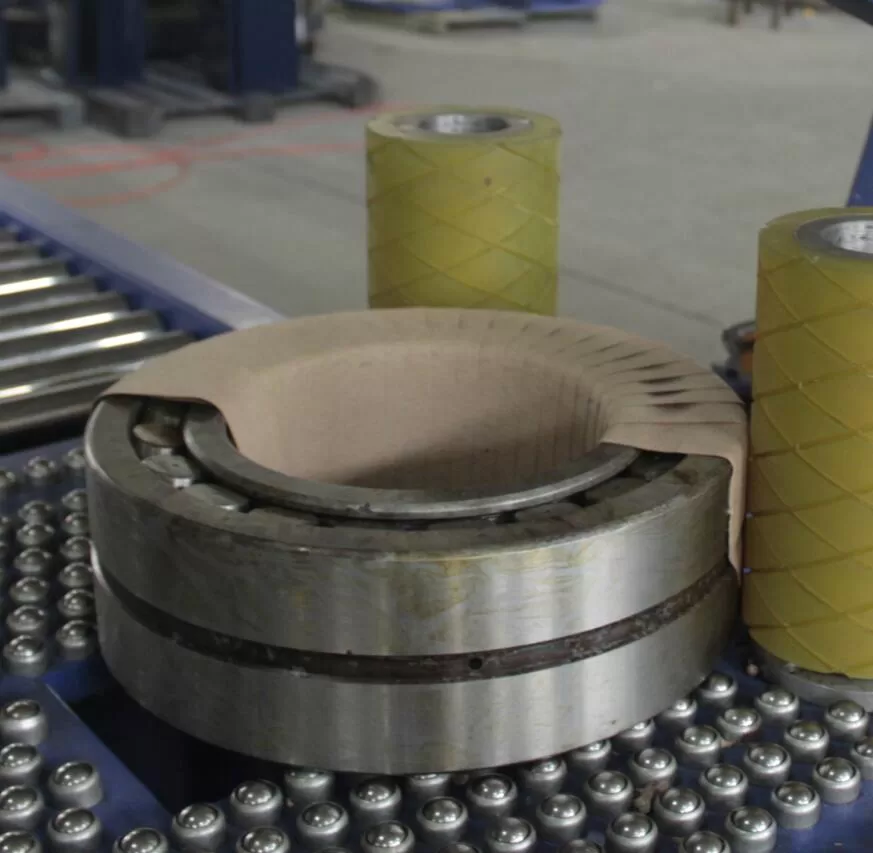Enhancing Bearing Longevity: A Guide to Automated Packing and Wrapping Solutions
Bearings, while robust in operation, are vulnerable components when it comes to handling, storage, and transport. Proper packaging is crucial not only to prevent physical damage from impacts and vibrations but also to protect against environmental factors like moisture and dust, which can lead to corrosion and contamination. Automated bearing packing and wrapping machines offer a systematic and efficient solution to ensure these critical components maintain their integrity from the production line to the point of use.
Understanding the Bearing Packing and Wrapping Process
Modern bearing packaging systems often combine two key functions into a single, integrated process:
- Protective Packing: The machine first applies a layer of protective material around the bearing. This initial layer serves as cushioning against shocks and can incorporate materials like Volatile Corrosion Inhibitor (VCI) paper or film to actively prevent rust and corrosion, a common concern for metal components during shipping and storage. Common materials include bubble wrap, foam sheeting, or VCI-treated materials.
- Secure Wrapping: Following the application of the protective layer, the machine tightly wraps the bearing with multiple layers of stretch film (such as Polyethylene or Polyvinyl Chloride). This outer wrapping secures the inner packing material, provides further stability, seals the bearing against external contaminants like dust and moisture, and unitizes the product for easier handling.

automatic bearing packing machine Key Features and Operation of Modern Bearing Packaging Systems
These automated or semi-automated systems are designed for industrial environments, emphasizing reliability and ease of use. Typical features include:
- Adjustability: Capable of handling a range of bearing sizes and weights, often with programmable settings.
- Material Compatibility: Designed to work with various standard packing materials (foam, bubble wrap, VCI) and wrapping films (PE, PVC).
- Control Systems: Often utilize Programmable Logic Controllers (PLCs) with Human-Machine Interface (HMI) touch screens for intuitive operation, parameter adjustments (e.g., wrap cycles, tension), and diagnostics.
- Tension Control: Adjustable film tension ensures a tight, secure wrap without damaging the bearing or packaging materials.
- Durable Construction: Built to withstand the demands of industrial production environments.
Materials Used in Bearing Packaging
Selecting the right materials is critical for effective bearing protection:
- Inner Packing Materials:
- Bubble Wrap/Foam: Provides cushioning against impact and vibration.
- VCI Paper/Film: Releases corrosion-inhibiting vapors within the package, protecting ferrous and non-ferrous metal surfaces. Essential for long-term storage or shipping through varying climates.
- Outer Wrapping Materials:
- Stretch Film (PE, PVC): Offers high tensile strength, puncture resistance, and cling properties to secure the load and provide a barrier against moisture and dirt.
Technical Specifications Overview
While specific machine capabilities vary, typical parameters for integrated bearing packing and wrapping systems might include:
- Machine Type: Integrated Packing and Wrapping Unit
- Typical Bearing Weight Capacity: Up to 100kg (systems for heavier bearings are available)
- Compatible Packing Materials: Bubble wrap, foam, VCI paper/film
- Compatible Film Types: Polyethylene (PE), Polyvinyl Chloride (PVC) stretch film
- Potential Throughput: Variable, potentially up to 40 bearings per hour depending on size and wrap requirements
- Common Power Requirement: e.g., 480V, 60Hz, three-phase (verify for specific model and region)
- Approximate Footprint (LxWxH): e.g., 3500mm x 1800mm x 2000mm (subject to configuration)
- Automation Level: Typically Semi-automatic or Fully Automatic
- Control Interface: PLC with HMI Touch Screen
- Wrapping Film Tension: Electronically or Mechanically Adjustable
Note: The parameters listed above represent common ranges and features. For exact specifications matching a particular application or the equipment shown in videos/images, direct consultation with the equipment manufacturer is necessary.

Applications Across Industries
Automated bearing packing and wrapping systems are valuable assets in various sectors:
- Heavy Industry Manufacturing (e.g., Steel, Mining, Construction Equipment): Provides essential protection for large, high-value bearings used in heavy machinery, ensuring they arrive on-site ready for installation without damage or corrosion.
- Automotive and Aerospace: Ensures that precision bearings used in critical applications meet stringent cleanliness and quality standards upon delivery, protecting against contamination and physical damage.
- General Manufacturing & Distribution: Streamlines end-of-line packaging processes for bearing manufacturers or distributors, improving throughput, consistency, and reducing manual handling risks associated with heavy components.
- Export Operations: Guarantees robust packaging capable of withstanding the rigors of long-distance shipping and diverse environmental conditions, maintaining bearing quality for international customers.
Benefits of Automated Bearing Packaging
Implementing automated packing and wrapping systems yields significant advantages:
- Enhanced Protection: Consistent application of protective materials and tight wrapping minimizes risk of damage from impact, vibration, moisture, and corrosion.
- Increased Efficiency: Automates a labor-intensive process, increasing packaging speed and overall throughput.
- Improved Consistency: Ensures every bearing is packaged to the same standard, enhancing quality control.
- Reduced Material Waste: Optimized use of packing and wrapping materials compared to manual methods.
- Enhanced Safety: Minimizes manual handling of potentially heavy or awkward bearings, reducing ergonomic risks.
By investing in appropriate packaging technology, manufacturers and distributors can safeguard their products, reduce losses due to damage, and ensure that bearings perform reliably as intended upon installation.